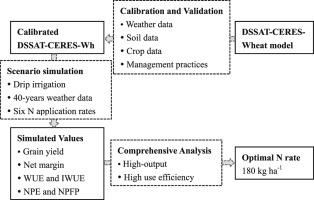当前位置:
X-MOL 学术
›
Agric. Water Manag.
›
论文详情
Our official English website, www.x-mol.net, welcomes your feedback! (Note: you will need to create a separate account there.)
Optimizing nitrogen application for drip-irrigated winter wheat using the DSSAT-CERES-Wheat model
Agricultural Water Management ( IF 6.7 ) Pub Date : 2021-02-01 , DOI: 10.1016/j.agwat.2020.106592 Zhuanyun Si , Muhammad Zain , Shuang Li , Junming Liu , Yueping Liang , Yang Gao , Aiwang Duan
Agricultural Water Management ( IF 6.7 ) Pub Date : 2021-02-01 , DOI: 10.1016/j.agwat.2020.106592 Zhuanyun Si , Muhammad Zain , Shuang Li , Junming Liu , Yueping Liang , Yang Gao , Aiwang Duan

|
Abstract Improper application of nitrogen fertilizer for winter wheat production in the North China Plain (NCP) limits N use efficiency and increases the risk of non-point pollution. Crop simulation models may help with the assessment of N fertilizer management, to improve nitrogen use efficiency and to mitigate environmental pollution. In this study, the DSSAT-CERES-Wheat model was calibrated and validated with two-year field experiment, which coupled with five N rates (0, 120, 180, 240, and 300 kg ha−1) and three irrigation levels (40, 30, and 20 mm per irrigation) under drip irrigation. The calibrated DSSAT-CERES-Wheat model performed well in simulating the anthesis date (nRMSE=1.47%, d=0.89), maturity date (nRMSE=0.97%, d=0.92), shoot biomass (nRMSE=10.97%, d=0.92), grain yield (nRMSE=6.19%, d=0.96), and actual evapotranspiration (nRMSE=9.96%, d=0.76) of drip-irrigated winter wheat in two years. The calibrated model was subsequently used to evaluate drip-irrigated winter wheat production in response to six N rates (0, 120, 180, 240, 300, and 360 kg ha−1) under 40 meteorological scenarios, and the results showed that grain yields, water use efficiency, irrigation water use efficiency, and net margins increased with increasing N application rates until it reached 180 kg ha−1. Above 180 kg ha−1, negligible changes were measured in these values as the N rate increased. The nitrogen physiological efficiency and nitrogen partial factor productivity were greatly improved at a N rate of 180 kg ha−1, compared with those at a N rate of 240, 300, and 360 kg ha−1. Consequently, N rate of 180 kg ha−1 was the optimal nitrogen application rate for drip-irrigated winter wheat production. These results may provide a scientific basis for nitrogen management of drip-irrigated winter wheat in the NCP.
中文翻译:

使用 DSSAT-CERES-Wheat 模型优化滴灌冬小麦的施氮量
摘要 华北平原冬小麦生产中氮肥施用不当限制了氮素的利用效率,增加了面源污染的风险。作物模拟模型可能有助于评估氮肥管理,提高氮利用效率并减轻环境污染。在本研究中,DSSAT-CERES-Wheat 模型通过为期两年的田间试验进行了校准和验证,结合了五个 N 比率(0、120、180、240 和 300 kg ha-1)和三个灌溉水平(40 、30 和 20 毫米每次灌溉)在滴灌下。标定的DSSAT-CERES-Wheat模型在模拟开花期(nRMSE=1.47%, d=0.89)、成熟期(nRMSE=0.97%, d=0.92)、地上部生物量(nRMSE=10.97%, d=0.92)方面表现良好)、谷物产量 (nRMSE=6.19%, d=0.96) 和实际蒸散量 (nRMSE=9.96%, d=0.76) 两年内滴灌冬小麦。随后使用校准模型评估了在 40 种气象情景下响应六种氮肥(0、120、180、240、300 和 360 kg ha-1)的滴灌冬小麦产量,结果表明粮食产量、用水效率、灌溉用水效率和净利润率随着施氮量的增加而增加,直到达到 180 kg ha−1。超过 180 kg ha-1,随着 N 率的增加,这些值的变化可以忽略不计。与施氮量为240、300和360 kg ha-1的施氮量相比,施氮量180 kg ha-1的氮生理效率和氮分因子生产力显着提高。因此,180 kg ha-1 的施氮量是滴灌冬小麦生产的最佳施氮量。
更新日期:2021-02-01
中文翻译:

使用 DSSAT-CERES-Wheat 模型优化滴灌冬小麦的施氮量
摘要 华北平原冬小麦生产中氮肥施用不当限制了氮素的利用效率,增加了面源污染的风险。作物模拟模型可能有助于评估氮肥管理,提高氮利用效率并减轻环境污染。在本研究中,DSSAT-CERES-Wheat 模型通过为期两年的田间试验进行了校准和验证,结合了五个 N 比率(0、120、180、240 和 300 kg ha-1)和三个灌溉水平(40 、30 和 20 毫米每次灌溉)在滴灌下。标定的DSSAT-CERES-Wheat模型在模拟开花期(nRMSE=1.47%, d=0.89)、成熟期(nRMSE=0.97%, d=0.92)、地上部生物量(nRMSE=10.97%, d=0.92)方面表现良好)、谷物产量 (nRMSE=6.19%, d=0.96) 和实际蒸散量 (nRMSE=9.96%, d=0.76) 两年内滴灌冬小麦。随后使用校准模型评估了在 40 种气象情景下响应六种氮肥(0、120、180、240、300 和 360 kg ha-1)的滴灌冬小麦产量,结果表明粮食产量、用水效率、灌溉用水效率和净利润率随着施氮量的增加而增加,直到达到 180 kg ha−1。超过 180 kg ha-1,随着 N 率的增加,这些值的变化可以忽略不计。与施氮量为240、300和360 kg ha-1的施氮量相比,施氮量180 kg ha-1的氮生理效率和氮分因子生产力显着提高。因此,180 kg ha-1 的施氮量是滴灌冬小麦生产的最佳施氮量。



























 京公网安备 11010802027423号
京公网安备 11010802027423号